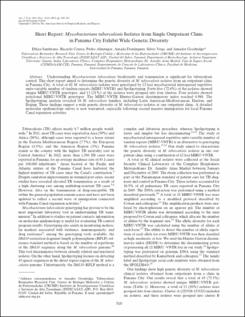| dc.contributor.author | Sambrano, Dilcia | |
| dc.contributor.author | Correa, Ricardo | |
| dc.contributor.author | Almengor, Pedro | |
| dc.contributor.author | Domínguez, Amada | |
| dc.contributor.author | Vega, Silvio | |
| dc.contributor.author | Goodridge, Amador | |
| dc.date.accessioned | 2020-06-30T23:45:44Z | |
| dc.date.available | 2020-06-30T23:45:44Z | |
| dc.date.issued | 2014-08-06 | |
| dc.identifier.other | doi:10.4269/ajtmh.14-0134 | |
| dc.identifier.uri | http://repositorio-indicasat.org.pa/handle/123456789/146 | |
| dc.description | Understanding Mycobacterium tuberculosis biodiversity and transmission is significant for tuberculosis control. This short report aimed to determine the genetic diversity of M. tuberculosis isolates from an outpatient clinic in Panama City. A total of 62 M. tuberculosis isolates were genotyped by 12 loci mycobacterial interspersed repetitive units-variable number of tandem repeats (MIRU-VNTR) and Spoligotyping. Forty-five (72.6%) of the isolates showed unique MIRU-VNTR genotypes, and 13 (21%) of the isolates were grouped into four clusters. Four isolates showed polyclonal MIRU-VNTR genotypes. The MIRU-VNTR Hunter-Gaston discriminatory index reached 0.988. The Spoligotyping analysis revealed 16 M. tuberculosis families, including Latin American-Mediterranean, Harlem, and Beijing. These findings suggest a wide genetic diversity of M. tuberculosis isolates at one outpatient clinic. A detailed molecular epidemiology survey is now warranted, especially following second massive immigration for local Panama Canal expansion activities. | en_US |
| dc.description.abstract | Understanding Mycobacterium tuberculosis biodiversity and transmission is significant for tuberculosis control. This short report aimed to determine the genetic diversity of M. tuberculosis isolates from an outpatient clinic in Panama City. A total of 62 M. tuberculosis isolates were genotyped by 12 loci mycobacterial interspersed repetitive units-variable number of tandem repeats (MIRU-VNTR) and Spoligotyping. Forty-five (72.6%) of the isolates showed unique MIRU-VNTR genotypes, and 13 (21%) of the isolates were grouped into four clusters. Four isolates showed polyclonal MIRU-VNTR genotypes. The MIRU-VNTR Hunter-Gaston discriminatory index reached 0.988. The Spoligotyping analysis revealed 16 M. tuberculosis families, including Latin American-Mediterranean, Harlem, and Beijing. These findings suggest a wide genetic diversity of M. tuberculosis isolates at one outpatient clinic. A detailed molecular epidemiology survey is now warranted, especially following second massive immigration for local Panama Canal expansion activities. | en_US |
| dc.language.iso | eng | en_US |
| dc.rights | info:eu-repo/semantics/openAccess | |
| dc.subject | Mycobacterium tuberculosis | en_US |
| dc.subject | MIRU-VNTR | en_US |
| dc.subject | Spoligotyping | en_US |
| dc.title | Mycobacterium tuberculosis Isolates from Single Outpatient Clinic in Panama City Exhibit Wide Genetic Diversity | en_US |
| dc.type | info:eu-repo/semantics/article | en_US |
| dc.type | info:edu-repo/semantics/publishedVersion | |

